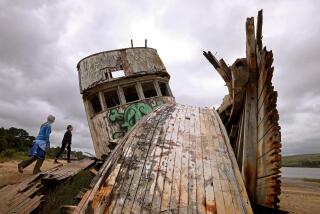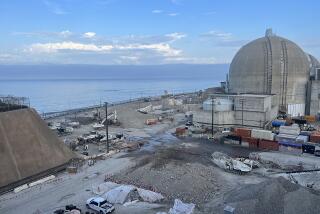A Fighting Carrierâs Last Scrap : Business: Ship breakers take cutting torches to the Bon Homme Richard, a veteran of three wars, to turn it into recycled metal.
Most people who look at the ship docked at Berth 240 on Terminal Island see an old Navy aircraft carrier called the Bon Homme Richard.
Richard Jaross sees future water faucets.
And not just water faucets, but also car parts, steel cable, street light poles, bridges, bicycles, baby carriages, filing cabinets, skyscrapers, tool sheds, lawn mowers--in short, almost anything that has metal in it.
The USS Bon Homme Richard may be a 900-foot-long World War II-era aircraft carrier now, but after Jaross and his company, Southwest Recycling Inc., finish with it, the ship will be 60 million pounds of scrap metal to be sold, melted down and reused in countless products.
âWeâre recycling it, just like youâd recycle cars or aluminum cans or anything else that society creates and then throws away,â Jaross, general manager of Southwest Recycling, says. âWhen weâre finished it will all be cut up into little pieces. There wonât be anything left.â
Jaross, 52, realizes that some people might see the slicing up of the Bon Homme Richard as a sad fate for the once-proud ship, which served in three wars. Jaross feels that way too.
âShips have characters, just like people,â he says. âSometimes Iâve walked on the decks or in the passageways and I can almost hear the voices of the men who served on her. Iâve cut up ships that I know men have died trying to save (in battle). Itâs a very emotional thing.â
But Jaross believes that recycling a warship is better than letting the vessel rust away, or using it for target practice as the Navy used to do with some of its old ships. And itâs certainly better, he says, than sending the carrier overseas to die, as is done with most ships these days.
âYou donât take good metal and just throw it away,â he says. âMetal is metal. Itâll last forever. And when an American ship dies it shouldnât be allowed to go to the grave in a foreign place.â
Jaross has spent several decades turning the now-useless into the again-usable. Soon after graduating from the University of Texas he started recycling old mechanical telephone switchboard equipment; later he recycled old railroad tracks. For a while he recycled old Atlas missile silos in Colorado, Kansas and Wyoming. Later he went into âship-breaking,â forming a Brownsville, Tex.-based company that dismantled more than 300 ships of all descriptions during the 1970s.
But in the late 1970s, the once-thriving U.S. ship-breaking business fell on hard times, beset by low-priced foreign competition. Although U.S. Navy warships by law must be recycled in the United States, old merchant ships are usually sent overseas for recycling. India is now the worldâs largest buyer of scrap ships. And while there used to be half a dozen major ship-breaking yards on the West Coast, Jaross says, now Southwest Recycling is the only one.
âItâs an economic and environmental disaster,â Jaross says of Third World dominance of the ship-breaking business. âThey can do it for a fraction of what it costs here, because they have no environmental laws, no safety regulations, no asbestos abatement requirements, nothing. And they pay their workers $60 or $70 a month. Here we not only pay high wages, but we also have strict environmental and safety regulations.â
â(The regulations) are tough, but I think most of them are necessary,â Jaross says. But he adds he would like to see other countries follow the same regulations, which increase a ship-breaking businessâs costs.
In fact, most domestic ship-breaking companies faded away a decade or more ago, unable to compete on the world market. Jaross sold his Texas company in 1980 and spent the next 10 years as what he calls a âwandering scrap man.â He worked on individual ship-breaking projects around the country and the world, and spent three years in the former Soviet Union helping that country set up ship-breaking yards.
The end of the Cold War and advances in ship-breaking technology finally convinced Jaross that a Los Angeles ship-breaking operation could compete in the world market. About a year ago Jaross and a group of investors formed Southwest Recycling and started cutting up old Navy ships. The Bon Homme Richard is the companyâs third ship, and the largest so far.
Built in 1944 at a cost of $35 million, the carrier was named after the Revolutionary War sailing ship commanded by John Paul Jones when he uttered his famous defiant line: âI have not yet begun to fight!â After combat service in the Pacific in World War II, the âBonnie Dickâ was decommissioned in 1947 and then reactivated for service in the Korean War.
After a major conversion, the carrier and its crew of 3,500 officers and men also served in the Vietnam War. The Bon Homme Richard was decommissioned for the last time in 1971, and remained in mothballs in Bremerton, Wash., for the next two decades. But eventually the carrier grew too old and obsolete. It was stripped of all usable military equipment and put up for sale.
The Bon Homme Richard is just one of many ships the Navy no longer needs. According to Navy Lt. Jacquie Yost, the Navy currently has 172 ships in mothballs around the country. Some are being held in reserve in case theyâre needed in a national emergency, some are destined for sale or lease to foreign governments, some will be given away for use as floating museums. But about 80 ships that have been in mothballs for 10 or 20 years are slated for disposal, Yost said.
In February, Southwest Recycling bought the Bon Homme Richard from the U.S. government for $528,000, and later had her towed to Terminal Island. This summer Jaross and Southwest Recycling had a farewell party for the ship, which was attended by about 800 people including some old sailors who had served aboard her. Pieces of her flight deck were sold as souvenirs at the event.
Then Jaross and his 55 employees got to work.
First the marine parts that were still usable--including generator parts, watertight doors, porthole covers and anchor chains--were removed and sold to marine supply houses. Then the breakers went to work with cutting torches, huge hydraulic shears and other equipment.
Jaross is somewhat secretive about the procedures and technology used in cutting up the ship. âWe donât want to give anything away to the competition,â he says. But eventually it will be reduced to pieces of metal about five feet square at the largest.
The ship is yielding steel, nickel, copper, brass, aluminum--almost every kind of metal. The cut-up pieces are transported by truck to scrap yards for sale.
Jaross wonât say how much the Bon Homme Richard is worth as scrap, but he pegs the average world price for scrap metal at over $100 a ton. With 30,000 tons of metal in the carrier, its scrap value would be about $3 million.
Although itâs being cut up in a U.S. port, the metal from the Bon Homme Richard probably will wind up overseas, Jaross says, with Korea and China being the most likely destinations. In case anyone wonders if metal from a ship that fought against Japan in World War II will be used in imported Hondas or Toyotas, Jaross says itâs unlikely, since in recent years Japan has been an exporter, not an importer, of scrap metal.
But even though the metal from the Bon Homme Richard will be sold overseas, it may eventually wind up back in the U.S. in imported manufactured products. And, Jaross points out, breaking up the ship here creates jobs and export dollars.
He also thinks that with the end of the Cold War, more such jobs and export dollars could be coming.
âThe Navyâs going to be down-sizing,â Jaross says. âThereâs probably going to be a lot of ships available for recycling.â
More to Read
Inside the business of entertainment
The Wide Shot brings you news, analysis and insights on everything from streaming wars to production â and what it all means for the future.
You may occasionally receive promotional content from the Los Angeles Times.







